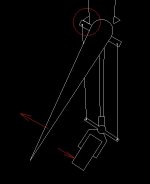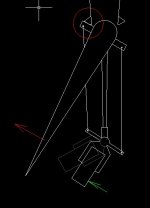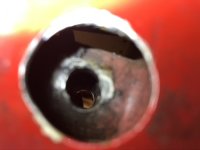VF84Sluggo
Well Known Member
.
Last edited:
I had to do the sameI had to shorten the tailwheel link very slightly as mentioned above. Mine had plenty of thread depth remaining so I just chased the threads and reassembled. Torque the lock nuts, a little dab of Torque Seal and you are back all set.


I wouldn't. Assuming the stops were set up as directed in the plans, and are symmetrical, the rudder isn't the problem. Don't fix one problem by introducing another.Dan, Would you recommend making new rudder stops instead of changing the chains/linkage?
Dan, Would you recommend making new rudder stops instead of changing the chains/linkage?

I did the same thing on my RV6 - taper pin - there’s a few posts about what’s needed to do that. The bolt that’s in there should be an AN4. Enlarging it to AN5 might work, but I would recommend going the taper pin route if that’s your problem. The hole in the fuselage weldment gets hogged out if the initial fit isn’t tight. Mine apparently wasn’t. The weldment metal (4130 steel I assume) is relatively soft compared to the stinger metal. The 386-2 taper pin, as recommended, has a minor diameter (upper end on mine since I tapered from the bottom up) of .255. This taper pin uses a 10-32 threaded end on the minor end. The upper end of the hole in my weldment was hogged out more than this so I had to upsize to a 386-3 taper pin, which has a 1/4-28 threaded end on the minor diameter. This works because the taper is the same on both pins - 1/2” per foot - and fortunately my reamer was long enough to enlarge the hole slightly so I didn’t have to buy another expensive taper pin reamer. Also mentioned is the torque applied to the taper pin nut. It should probably be no more than 1/2 the standard AN 10-32, or AN 1/4-28 nut torque. Removing it, if ever needed can be very difficult.View attachment 66441
One thing to check: The tail spring is held into the fuselage by a single AN3 bolt (I think AN3).
The hole in the fuselage tube may tend to enlarge and allow the tail wheel to lean left or right. Picture attached of enlarged hole.
If that is the case you may be able to ream the tube and the tail spring to AN4. Or as I did, ream the hole and tail spring for a taper pin.
Hi Rod, do you feel much difference in the handling after this change? As an aside, during my flight testing, I stuck an action camera back there pointed onto the tailwheel to see what it's doing. I was quite surprised at what I saw, and I inferred that the stresses back there are pretty substantial, particularly on rougher surfaces.I ended up adding a .75 inch extension to get proper release. I could use another 1/8 inch the release is right at full deflection.
View attachment 67221
Just installed and I've only got 3 landings with the extension but it's much less "nervous" on landing,
Yes my mains are shimmed for proper toe!